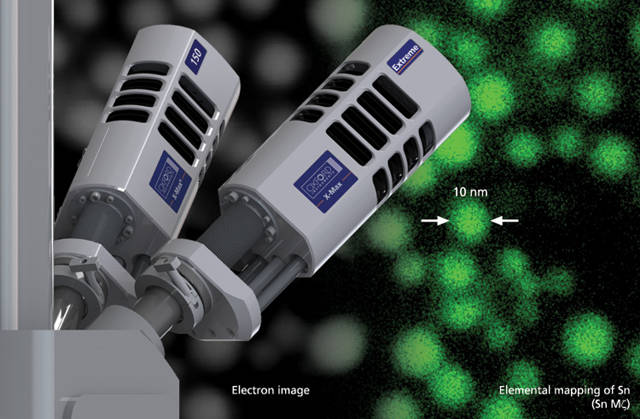Oxford Instruments, a world leader in microanalysis systems, has launched X-Max Extreme, a Silicon Drift Detector that promises to be a breakthrough solution for ultra high resolution FEG and FIB-SEM applications.
 The EDS spatial resolution using Oxford Instruments’ X-Max Extreme approaches that of the SEM. Background: X-ray map resolution test using tin nanospheres on a carbon imaging standard. EDS acquisition at 2 kV at 5 mm working distance using X-Max Extreme. Spatial resolution approaches that of the SEM – a breakthrough in EDS capability.
The EDS spatial resolution using Oxford Instruments’ X-Max Extreme approaches that of the SEM. Background: X-ray map resolution test using tin nanospheres on a carbon imaging standard. EDS acquisition at 2 kV at 5 mm working distance using X-Max Extreme. Spatial resolution approaches that of the SEM – a breakthrough in EDS capability.
This unique detector for the first time enables EDS data collection at very low kV (e.g. between 1kV and 3kV) and a very short working distance to provide elemental analysis under the conditions used to analyse nano-materials and surfaces at the highest SEM resolution.
The latest ultra-high resolution FEG-SEMs offer exciting new capabilities for investigating smaller nano-structures, interfaces and surfaces. However, under the operating conditions used to make use of new electron signal contrasts from in-lens detectors - very short working distance, very low kV and minimal beam current - no traditional SDD could provide supporting elemental characterisation. The new X-Max Extreme changes this. With X-Max Extreme, both imaging and EDS performance can be performed simultaneously and the EDS resolution approaches that of the SEM.
X-Max Extreme is based on a windowless 100mm2 detector; it uses a radical geometry to enable data acquisition under short working distance. It therefore provides elemental analysis under the same conditions used to analyse nano-materials and surfaces at the highest SEM resolution.
According to X-ray Business Manager, Dr. Simon Burgess, “X-Max delivers solutions beyond conventional micro- and nano- analysis. For example, the sensitivity of the Extreme allows users to characterise the composition and distribution of surface contaminants and layers a few atoms thick. It also provides superb detection of light elements, including lithium.”
X-Max Extreme was launched at M&M 2015 in Portland, Oregon in August, where it was demonstrated on the show floor.
About Oxford Instruments plc
Oxford Instruments designs, supplies and supports high-technology tools and systems with a focus on research and industrial applications. Innovation has been the driving force behind Oxford Instruments' growth and success for over 50 years, and its strategy is to effect the successful commercialisation of these ideas by bringing them to market in a timely and customer-focused fashion.
The first technology business to be spun out from Oxford University, Oxford Instruments is now a global company and is listed on the London Stock Exchange (OXIG). Its objective is to be the leading provider of new generation tools and systems for the research and industrial sectors with a focus on nanotechnology. Its key market sectors include nano-fabrication and nano-materials. The company’s strategy is to expand the business into the life sciences arena, where nanotechnology and biotechnology intersect
This involves the combination of core technologies in areas such as low temperature, high magnetic field and ultra high vacuum environments; Nuclear Magnetic Resonance; X-ray, electron, laser and optical based metrology; atomic force microscopy; optical imaging; advanced growth, deposition and etching.
Oxford Instruments aims to pursue responsible development and deeper understanding of our world through science and technology. Its products, expertise, and ideas address global issues such as energy, environment, security and health.